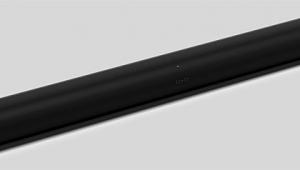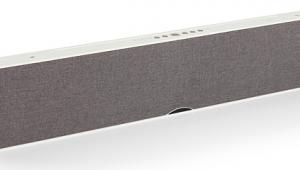Arcam Solo Soundbar System Review

AT A GLANCE
Plus
HDMI, lossless surround decoding
UHD-capable video passthrough
Minus
High-end pricing
No HDCP 2.2 DRM for UHD
THE VERDICT
If you close your eyes, the Arcam Solo Bar and Solo Sub sound more like a decent component system than a soundbar.
Soundbars take three forms. The main distinction among them is what serves as the heart of your system. With a passive soundbar, the A/V receiver—with all its features, joys, and woes—is the clearinghouse, and all signal sources go through it. With a less expensive active soundbar, the TV often replaces the receiver, and all signals go through the TV into the bar. But the Arcam Solo Bar is the type of active soundbar that replaces both the receiver and the TV as the heart of your system.
Two Firsts
The Solo Bar, here reviewed with the Solo Sub, has some unusual talents. Its HDMI switching passes Ultra HD at frame rates up to 30 hertz with a color space of 4:4:4 (uncompressed) or 60 Hz with 4:2:0 (the dominant setting for current UHD). “We are unaware of any other product that does all this,” says Arcam. Unfortunately, however, this first generation of Solo does not include HDCP 2.2 digital rights management, so the bar can’t pass UHD signals with that DRM, and that’s likely to include a lot of emerging UHD content and services. That aside, the Solo Bar/Sub is also the first soundbar system I’ve reviewed with auto setup and room correction. A soundbar that dares to correct the room: That’s moxie.
With HDMI, the Solo Bar can decode DTS-HD Master Audio and Dolby TrueHD lossless surround. In contrast, TV-centric soundbars are usually limited to lossy Dolby Digital, often down-mixed to stereo. Like many bars, the Solo offers Bluetooth aptX wireless capability. But Arcam ups the ante with two-way streaming, so you can stream not only from mobile device to bar but also from bar to Bluetooth headphones. Furthermore, your smartphone or tablet can control the Solo system with a phone-sized app for iOS or Android.
The Solo Bar comes dressed to kill in an aluminum enclosure. While that might not account for the entire price differential between this $1,500 product and its plastic competition, it does a lot to control resonance and banish coloration. Twelve inches of its 43.3-inch width are devoted to a shiny center section with a large blue dimmable or defeatable display and five buttons controlling power, input, and volume.

Behind the perforated metal grilles of the two-channel bar are four 4-inch woofers and two 1-inch silk-dome tweeters. They are biamplified with 50 watts RMS per side; 10 watts go to the tweeter, and 40 watts are shared between the pair of woofers. The Solo Sub’s down-firing 10-inch driver gets a substantial 300 watts RMS of its own.
On the bar’s back panel are four HDMI 1.4b inputs and one ARCcapable output. HDMI includes CEC to handle other components. Digital coaxial and optical inputs are provided for legacy sources. The sole analog input is a minijack (not including the setup mic input). There is an RCA-type subwoofer output, compatible with any active sub.

The small remote control has helpfully large buttons. In addition to duplicating the front panel’s power, input, and volume controls, the remote has a half-dozen menu navigation buttons for the front-panel display (no onscreen display) plus mute, automatic level control, and sound mode. Modes include the default setting of Stereo plus Movie and Concert options, the latter two with only modest processing—nothing grossly unnatural. The control app duplicates the handheld remote.
The Solo Sub is a lot more substantial than the lightweight models provided with most soundbars, justifying much of its $800 price tag. Its charcoal-gray enclosure is machined from fiberboard into a trapezoid shape similar to Monty Python’s 16-ton weight (you young’uns can Google it), though lighter, at 27.3 pounds. It is wireless but also has stereo and LFE RCA inputs for a wired connection. In addition to the usual power, phase, volume, and crossover frequency controls, it has a dial for crossover Q, which controls the slope of the rolloff curve to match another surround processor. When the Solo Sub is used with the Solo Bar, Arcam recommends a crossover frequency of 85 Hz (requiring meaningful bass output from the bar) and a crossover Q of 1.1.
To set up the system, I connected both my Oppo BDP-83SE universal disc player and my cable box to the HDMI inputs, the HDMI output to my TV, and the auto setup mic. The auto setup and room EQ program ran quickly. Pairing the sub required me to burrow into the bar’s menu, then hold down a button on the back of the sub for five seconds. Arcam recommends a slight upward tilt of the Solo Bar towards the listening position, though the table I used was high enough to make this unnecessary.
 The one initial setup problem was related to subwoofer volume. The wireless pairing worked, but sub output was so low that I had to crank the volume all the way up to get any audible sound. A temporary solution was to do a full system reset, with no subsequent auto setup, plus a wired sub connection. However, a later software update (version 1.14) increased the wireless sub level relative to the bar and eliminated the sub from room EQ. This provided much more headroom for the sub. I used the original room EQ for the movie demos, no EQ for the music demos, and the new EQ for last-minute listening.
The one initial setup problem was related to subwoofer volume. The wireless pairing worked, but sub output was so low that I had to crank the volume all the way up to get any audible sound. A temporary solution was to do a full system reset, with no subsequent auto setup, plus a wired sub connection. However, a later software update (version 1.14) increased the wireless sub level relative to the bar and eliminated the sub from room EQ. This provided much more headroom for the sub. I used the original room EQ for the movie demos, no EQ for the music demos, and the new EQ for last-minute listening.
The Dog That Didn’t Bark
The Solo Bar’s most conspicuous sonic traits were absences: of plastic-box midrange coloration, of stridency at the top end, of honkiness and sibilance and other obvious disfigurements of voices. The tweeters are angled outward by 5 degrees, affording a bit of extra perceived width, though the soundstage didn’t stray far from the bar in any mode. The Solo Sub (with updated EQ or none at all) offered loads of output but with more subtlety and control than the bloat boxes packaged with most soundbars. Divorced from the initial imperfect EQ, it was the best soundbar-supporting sub I’ve heard. Room EQ brightened the Solo Bar’s tonal balance slightly, though this was offset when I switched from the default Stereo mode to the Movie mode.
The Solo system’s maiden voyage was The Interview, Kim Jong-un’s favorite movie (Netflix, Dolby Digital Plus). When James Franco’s talk-show star tells Seth Rogen’s producer that the first rule of journalism is “give the people what they want,” the producer replies: “That’s not the first rule of journalism. I think that’s the first rule of, like, circuses and demolition derbies”—this movie, for example. Amid the over-the-top gunplay, gore, and explosions, the Solo Bar kept its cool, stepping up the bombast without dissolving into obvious distortion.
- Log in or register to post comments





































































